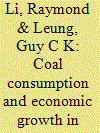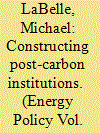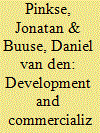|
|
|
Sort Order |
|
|
|
Items / Page
|
|
|
|
|
|
|
| Srl | Item |
| 1 |
ID:
111087


|
|
|
|
|
| Publication |
2012.
|
| Summary/Abstract |
This paper addresses the dual questions: What is the appropriate storage size and its related properties for matching very large photovoltaic plants to the grid; and what are the available technologies for achieving this end. For this purpose a "Usefulness Index" is defined, which, for any grid flexibility, leads to a PV-storage combination that allows high grid-penetration without storage being wastefully large. The paper then examines the sensitivity of this "appropriate storage size" to variations in our assumptions. The specific case of the Israeli electricity grid is employed for numerical discussion, but the formalism should be useful for wider application. In particular, the "appropriate storage size" deduced in this manner is argued to be a valuable point of departure for optimizations of a more sophisticated nature. Regarding available storage technologies, none is found to have all of the required properties for massive PV-grid penetration, but hybrid combinations should be capable of achieving this end.
|
|
|
|
|
|
|
|
|
|
|
|
|
|
|
|
| 2 |
ID:
111084


|
|
|
|
|
| Publication |
2012.
|
| Summary/Abstract |
How do policy actions affect the dynamics of deregulated electricity prices? We investigate this issue in the context of the Italian Power Exchange (IPEX), using data on the daily average day-ahead price (PUN) between April 2004 and December 2008.
Estimates of baseline time series models (SARMAX and SARMAX-EGARCH) and their forecasting performances suggest that the trend in natural gas prices, market power indicators, deterministic weekly patterns, perceived temperatures, persistence in conditional volatility, and the inverse leverage effect are essential features of the PUN dynamics. We then augment the best-performing models with dummies that account for changes in the market architecture, such as the introduction of contracts for differences (CfDs) to support renewables, trading of white certificates for energy efficiency, and the demand-side liberalization. The findings show that changes in the market architecture affected both the PUN level and its volatility. Specifically, wholesale electricity prices and volatility appear to have decreased upon the introduction of CfDs, only to be pushed upwards following the start of white certificates' trading and retail liberalization. Moreover, after controlling for reforms the inverse leverage effect vanishes, and the persistence in volatility is lower than in the baseline estimates.
|
|
|
|
|
|
|
|
|
|
|
|
|
|
|
|
| 3 |
ID:
111074


|
|
|
|
|
| Publication |
2012.
|
| Summary/Abstract |
The combination of a prime mover and an energy storage device for reduction of fuel consumption has successfully been used in automotive industry. The shipping industry has utilised this for conventional submarines. The potential of a load levelling strategy through use of a hybrid battery-diesel-electric propulsion system is investigated. The goal is to reduce exhaust gas emissions by reducing fuel oil consumption through consideration of a re-engineered ship propulsion system. This work is based on operational data for a shipping fleet containing all types of bulk carriers. The engine loading and the energy requirements are calculated, and sizing of suitable propulsion and the battery storage system are proposed. The changes in overall emissions are estimated and the potential for fuel savings identified. The efficiency of the system depends on the storage medium type, the availability of energy and the displacement characteristics of the examined vessels. These results for the global fleet indicate that savings depending on storage system, vessel condition and vessel type could be up to 0.32 million tonnes in NOx, 0.07 million tonnes in SOx and 4.1 million tonnes in CO2. These represent a maximum 14% of reduction in dry bulk sector and 1.8% of world's fleet emissions.
|
|
|
|
|
|
|
|
|
|
|
|
|
|
|
|
| 4 |
ID:
111078


|
|
|
|
|
| Publication |
2012.
|
| Summary/Abstract |
The digitalization of the electricity grid opens the way to bundle value added services to the electricity commodity, and possibly shift business value to electricity services in line with the notions of efficiency, conservation and sustainability. In this context, market forces should be mobilized within the boundaries of energy policy goals to contribute to the massive investments that are required to fulfill the Smart Grid vision. In this paper, we present a systemic perspective aimed at establishing technical and economic synergies that may improve the business cases of individual different Smart Grid technologies and contribute to reverse the consumption-driven paradigm of the electricity sector. Our analysis is supported by evidence from applications in the electric vehicle and smart meter ecosystems. Throughout the paper, an EU (European Union) perspective is primarily considered.
|
|
|
|
|
|
|
|
|
|
|
|
|
|
|
|
| 5 |
ID:
111064


|
|
|
|
|
| Publication |
2012.
|
| Summary/Abstract |
The carbon market experiences of Brazil and India represent policy success stories under several criteria. A careful evaluation, however, reveals challenges to market development that should be addressed in order to make the rollout of a post-2012 CDM more effective. We conducted firm-level interviews covering 82 CDM plants in the sugar and cement sectors in Brazil and India, focusing on how individual managers understood the potential benefits and risks of undertaking clean development mechanism (CDM) investments. Our results indicate that the CDM operates in a far more complex way in practice than that of simply adding a marginal increment to a project's internal rate of return. Our results indicate the following: first, although anticipated revenue played a central role in most managers' decisions to pursue CDM investments, there was no standard practice to account for financial benefits of CDM investments; second, some managers identified non-financial reputational factors as their primary motivation for pursuing CDM projects; and third, under fluctuating regulatory regimes with real immediate costs and uncertain CDM revenue, managers favored projects that often did not require carbon revenue to be viable. The post-2012 CDM architecture can benefit from incorporating these insights, and in particular reassess goals for strict additionality and mechanisms for achieving it.
|
|
|
|
|
|
|
|
|
|
|
|
|
|
|
|
| 6 |
ID:
111080


|
|
|
|
|
| Publication |
2012.
|
| Summary/Abstract |
Since reform and opening-up in 1978, the coal industry in China has been developing rapidly. This article identified major factors affecting the growth of China's coal industry, immediate targets, economic policies, as well as structural reforms of the sector. Authors have divided its developing process into three stages: rapid growth of coal industry (1979-1992); close-down of small-scale coal mines (SCMs) (1993-2001); resource consolidation (2002-present). At the first stage, led by the 'two-leg walking' strategy, SCMs grew significantly, which eased the pressure of energy shortage. From the transition of planned economy to market economy, major state-owned coal mines (MSCs), which were not consistently profitable, would have to learn how to withstand severe competitions and survive. As a result, the central government took several measures to try to keep them alive. This situation was not changed until 2001. Large-scaled coal mine groups were then established by the government when China entered the WTO. MSCs were encouraged to merge with others to form a certain scale, as a way to compete with giant overseas. So a trial was firstly implemented in Shanxi province.
|
|
|
|
|
|
|
|
|
|
|
|
|
|
|
|
| 7 |
ID:
111096


|
|
|
|
|
| Publication |
2012.
|
| Summary/Abstract |
The aim of this paper is to re-examine the relationship between coal consumption and real GDP of China with the use of panel data. This paper applies modern panel data techniques to help shed light on the importance of the heterogeneity among different regions within China. Empirical analyses are conducted for the full panel as well as three subgroups of the panel. The empirical results show that coal consumption and GDP are both I(1) and cointegrated in all regional groupings. Heterogeneity is found in the GDP equation of the full panel. The regional causality tests reveal that the coal consumption-GDP relationship is bidirectional in the Coastal and Central regions whereas causality is unidirectional from GDP to coal consumption in the Western region. Thus, energy conservation measures will not adversely affect the economic growth of the Western region but such measures will likely encumber the economy of the Coastal and Central regions, where most of the coal intensive industries are concentrated.
|
|
|
|
|
|
|
|
|
|
|
|
|
|
|
|
| 8 |
ID:
111101


|
|
|
|
|
| Publication |
2012.
|
| Summary/Abstract |
The development of feed-in tariff (FIT) programs to support green electricity in Ontario (the Green Energy and Green Economy Act of 2009) and Germany (the Erneuerbare Energien-Gesetz of 2000) is compared. The two policies are highly comparable, offering similar rates for most renewable electricity technologies. Major differences between the policies include the level of differentiation found in the German policy, as well as the use of a price degression strategy for FIT rates in Germany compared to an escalation strategy in Ontario. The German renewable electricity portfolio is relatively balanced, compared to Ontario where wind power dominates the portfolio. At the federal level, Canada does not yet have a policy similar to the European Directive on Renewable Energy, and this lack may impact decisions taken by manufacturers of renewable technologies who consider establishing operations in the province. Ontario's Green Energy and Green Economy Act could be benefit from lessons in the German system, especially with regard to degression of feed-in tariff rates over time, which could significantly reduce payments to producers over the course of a contract, and in turn encourage greater competitiveness among renewable power providers in the future.
|
|
|
|
|
|
|
|
|
|
|
|
|
|
|
|
| 9 |
ID:
111092


|
|
|
|
|
| Publication |
2012.
|
| Summary/Abstract |
This paper examines three different governance approaches the European Union (EU) and Member States (MS) are relying on to reach a low carbon economy by 2050. Current governance literature explains the operational methods of the EU's new governance approach to reduce carbon emissions. However, the literature neglects to account for the perceived risks that inhibit the roll-out of new low carbon technology. This article, through a novel approach, uses a grounded theoretical framework to reframe traditional risk literature and provides a connection to governance literature in order to assess the ability of EU governance mechanisms to reduce carbon emissions. The empirical research is based on responses from European energy stakeholders who participated in a Delphi method discussion and in semi-structured interviews; these identified three essential requirements for carbon emissions to be reduced to near zero by 2050: (1) an integrated European energy network, (2) carbon pricing and (3) demand reduction. These features correspond to institutionalized responses by the EU and MS: the Agency for the Cooperation of Energy Regulators (ACER); European Union Emission Trading Scheme (EU ETS) and energy efficiency directives and policies integrated into existing MS institutions. The theoretical and empirical findings suggest that governance by facilitation (energy efficiency) fails to induce significant investment and new policy approaches and cannot be relied on to achieve requisite reductions in demand. Governance by negotiation (ACER) and governance by hierarchy (EU ETS) do reduce risks and may encourage the necessary technological uptake. The term 'risk governance' is used to explain the important role governance plays in reducing risks and advancing new technology and thereby lowering carbon emissions in the energy sector.
|
|
|
|
|
|
|
|
|
|
|
|
|
|
|
|
| 10 |
ID:
111056


|
|
|
|
|
| Publication |
2012.
|
| Summary/Abstract |
In diversifying energy supply, the transformation of the energy industry has been identified as a key challenge for a sustainable energy future. This suggests that incumbent firms in this industry have a vital role in the development and commercialization process of renewable energy technologies. This paper provides a comparative analysis of oil and gas firms' strategies regarding solar PV technology investments, a renewable energy technology that has seen explosive growth of late. The main aim is to examine the strategic approach of incumbent firms in the oil and gas industry towards the development and commercialization of solar PV technology. To investigate this, a multiple case study has been conducted within the European oil industry, focusing on the three largest oil and gas firms: BP, Royal Dutch/Shell, and Total. Findings show that oil and gas firms have difficulties with integrating solar PV technology in their supply chain. The analysis suggests that it is uncertain whether all oil and gas firms will abandon solar completely, as this depends to what extent they are able to generate profits. Nevertheless, there is currently a trend in the oil industry of leaving solar and positioning towards a 'recarbonization' of business activities.
|
|
|
|
|
|
|
|
|
|
|
|
|
|
|
|
| 11 |
ID:
111081


|
|
|
|
|
| Publication |
2012.
|
| Summary/Abstract |
This article is study of Azerbaijan oil and gas industry. It illustrates the business climate, the impact of this sector on Azerbaijan's economy including role of SOFAZ and highlights recent developments in the energy production and the main concepts of Azeri PSAs (2009). Meanwhile, the article establishes the government policy by indentifying several factors that influenced to attract foreign investment to oil and gas sector and examines significant challenges that still remain for further development of the country's oil industry.
|
|
|
|
|
|
|
|
|
|
|
|
|
|
|
|
| 12 |
ID:
111100


|
|
|
|
|
| Publication |
2012.
|
| Summary/Abstract |
This paper assesses the relationship among energy consumption, financial development, economic growth, industrialization and urbanization in Tunisia from 1971 to 2008. The autoregressive distributed lag bounds testing approach to cointegration and Granger causality tests is employed for the analysis. The result confirms the existence of long-run relationship among energy consumption, economic growth, financial development, industrialization and urbanization in Tunisia. Long-run bidirectional causalities are found between financial development and energy consumption, financial development and industrialization, and industrialization and energy consumption. Hence, sound and developed financial system that can attract investors, boost the stock market and improve the efficiency of economic activities should be encouraged in the country. Nevertheless, promoting industrialization and urbanization can never be left out from the process of development. We add light to policy makers with the role of financial development, industrialization and urbanization in the process of economic development.
|
|
|
|
|
|
|
|
|
|
|
|
|
|
|
|
| 13 |
ID:
111070


|
|
|
|
|
| Publication |
2012.
|
| Summary/Abstract |
Per capita consumption1 of electricity in India is many folds lesser than Canada, USA, Australia, Japan, Chaina and world average. Even though, total energy shortage2 and peaking shortage3 were recorded as 11.2% and 11.85%, respectively, in 2008-09 reflecting non-availability of sufficient supply of electricity. Performance improvement of very small amount can lead to large contribution in financial terms, which can be utilized for capacity addition to reduce demand supply gap. Coal fired thermal power plants are main sources of electricity in India. In this paper, relative technical efficiency of 60 coal fired power plants has been evaluated and compared using CCR and BCC models of data envelopment analysis. Target benchmark of input variables has also been evaluated. Performance comparison includes small versus medium versus large power plants and also state owned versus central owned versus private owned. Result indicates poor performance of few power plants due to over use of input resources. Finding reveals that efficiency of small power plants is lower in comparison to medium and large category and also performance of state owned power plants is comparatively lower than central and privately owned. Study also suggests different measures to improve technical efficiency of the plants.
|
|
|
|
|
|
|
|
|
|
|
|
|
|
|
|
| 14 |
ID:
111069


|
|
|
|
|
| Publication |
2012.
|
| Summary/Abstract |
Very little work has been done so far to model, test, and understand the relationship between oil prices and EROI over time. This paper investigates whether a declining EROI is associated with an increasing oil price and speculates on the implications of these results on oil policy. A model of the relationship between EROI and oil market prices was developed using basic economic and physical assumptions and non-linear least-squares regression models to correlate oil production price with EROI using available data from 1954-1996. The model accurately reflects historical oil prices (1954-1996), and it correlates well with historical oil prices (1997-2010) if a linear extrapolation of EROI decline is assumed. As EROI declines below 10, highly non-linear oil price movements are observed. Increasing physical oil scarcity is already providing market signals that would stimulate a transition away from oil toward alternative energy sources. But, price signals of physical oil scarcity are not sufficient to guarantee smooth transitions to alternative fuel sources, especially when there is insufficient oil extraction technology development, a declining mark-up ratio, a non-linear EROI-cost of production relationship, and a non-linear EROI-price relationship.
|
|
|
|
|
|
|
|
|
|
|
|
|
|
|
|
| 15 |
ID:
111098


|
|
|
|
|
| Publication |
2012.
|
| Summary/Abstract |
In order to reduce the energy consumption of the building stock, a major trend is to drastically reduce the space-heating (SH) needs by improving the thermal performance of the envelope. In general, this measure is combined with efficient heating systems to minimize the delivered energy and greenhouse gas emissions. Nevertheless, these better systems are often more expensive so that the extra-investment could be hardly recovered for small-scale energy consumption. The main objective of the article is to show how equilibria between cost-effectiveness and environmental performance of heating systems are changed when small SH needs are considered (i.e. for passive and low-energy houses). The scope is limited to new single-family dwellings. Furthermore, the passive house standard provides means of simplifying the SH by using the ventilation air: the idea is that savings should counterbalance the extra-investment in super-insulation. In theory, a new global economic optimum is generated at the passive house level. The second objective of the work is to study which conditions could lead to this new optimum. Only a detached-house typology is investigated to address this last issue. Regarding methodology, all the investigations are done considering the Belgian context. Energy and environmental performance is evaluated using a method that complies with the EN-15603 and EN-15316 standards.
|
|
|
|
|
|
|
|
|
|
|
|
|
|
|
|
| 16 |
ID:
111097


|
|
|
|
|
| Publication |
2012.
|
| Summary/Abstract |
The perennial political and social upheavals in major oil-producing regions, the increasing energy demand from emerging economies, the global economic crisis and even environmental disasters, like the recent major oil spill in the Gulf of Mexico, all contribute to price fluctuations and escalations. Usually price instability affects the least-developed countries with the most fragile economies, like Ghana, the most. This paper gives a brief overview of the Ghanaian energy situation, describes the liquid biofuel production processes and examines the possibility of replacing some of the fossil fuels consumed annually, with locally produced renewable biofuels. Various scenarios for substituting different portions of petrol and diesel with biofuels derived from cassava and palm oil are examined. Based on 2009 crop production and fuel consumption data, replacement of 5% of both petrol and diesel with biofuels would require 1.96% and 17.3% of the cassava and palm oil produced in that year, respectively; while replacement of 10% of both fossil fuels would need 3.91% and 34.6% of the corresponding biofuels. Thus while petrol replacement could be initiated with little difficulty, regarding raw material availability, biodiesel would require enhanced palm oil production and/or oil supplement from other sources, including, potentially, jatropha. An implementation strategy is proposed.
|
|
|
|
|
|
|
|
|
|
|
|
|
|
|
|
| 17 |
ID:
111089


|
|
|
|
|
| Publication |
2012.
|
| Summary/Abstract |
Increasing awareness on environmental damage and climate change has induced many nations to engage in green growth. South Korea, as one of the largest consumers of energy, is no exception and has shown its determination to pursue green growth in the future. In order to do so, South Korea plans to substitute fossil fuel with alternative sources in electricity generation. However, the key constraint to green growth is the high cost faced by renewable electricity generation. Fortunately, nuclear energy can serve as an economic alternative to fossil fuel. To achieve CO2 emission reduction and faster economic growth, it is wise to analyze prospects of alternatives using experience curve framework. The results and industry background are consistent for nuclear technology, and the results suggest that nuclear should serve as the main substitute. Consideration of policy risk inherent in renewable also strengthens the argument. Renewable technologies, on the other hand, showed overstated learning capacity that is partially inconsistent with technological background. Nevertheless, the renewable (photovoltaic and fuel cell2) should help nuclear marginally in substituting fossil fuel in South Korea's Electricity Generation.
|
|
|
|
|
|
|
|
|
|
|
|
|
|
|
|
| 18 |
ID:
111085


|
|
|
|
|
| Publication |
2012.
|
| Summary/Abstract |
Oil is the world's most important commodity, and improving the understanding of drivers of its price is a longstanding research objective. This article analyses real oil prices during 1984-2007 using a monthly dataset of fundamental and market parameters that cover financial markets, global economic growth, demand and supply of oil, and geopolitical measures. The innovation is to incorporate proxies for speculative and terrorist activity and dummies for major industry events, and quantify price impacts of each. New findings are positive links between oil prices and speculative activity, bond yields, an interaction term incorporating OPEC market share and OECD import dependence, and the number of US troops and frequency of terrorist attacks in the Middle East. Shocks also prove significant with a $6-18 per barrel impact on price for several months.
|
|
|
|
|
|
|
|
|
|
|
|
|
|
|
|
| 19 |
ID:
111068


|
|
|
|
|
| Publication |
2012.
|
| Summary/Abstract |
Policies to address climate change by reducing greenhouse gas emissions might be made more effective if we can better understand the pathways by which transformative technologies become significant components of energy systems. Indeed, the central question of mitigation revolves around the scope of policy to influence or accelerate the diffusion of low-carbon technology. While market forces clearly influence technology deployment, understanding the longer-term and large-scale changes in the energy system requires a broader understanding of the relative influence of institutional, behavioral, and social factors. This paper presents the results of an interview-based, comparative case approach to investigating systematically the relative importance of these non-economic factors influencing technological change across technology and country contexts. We identified two low-carbon energy sectors (bioenergy and nuclear power) that underwent significant changes over the past 50 years in the energy portfolio of three countries: Brazil, Sweden, and the United States. We identified nine categories of factors that might contribute to these large technological transformations, and then evaluated, via interviews with sector participants in each country, which factors were viewed as being determinative or highly influential in the trajectory of that technology in their country context. We also draw out policy implications and directions for future research.
|
|
|
|
|
|
|
|
|
|
|
|
|
|
|
|
| 20 |
ID:
111060


|
|
|
|
|
| Publication |
2012.
|
| Summary/Abstract |
The appropriate cost of capital for a renewable energy project depends upon an accurate measure of investment risk. Employing the conceptual framework of a commonly accepted asset pricing model, we analyze the risk faced by renewable energy investors in large emerging markets. We find that firms in Brazil, China and India expose multinational investors to the same risk as investing in emerging markets generally. The risk to domestic investors in those same firms ranges from substantially below-average to above-average, depending upon the country. The results are robust across several model versions and statistical techniques. With an eye toward government efforts to encourage the deployment of renewable energy in developing countries, we establish a range of estimates for the required return on equity capital in this fast-growing and politically important economic sector.
|
|
|
|
|
|
|
|
|
|
|
|
|
|
|
|
|
|
|
|
|